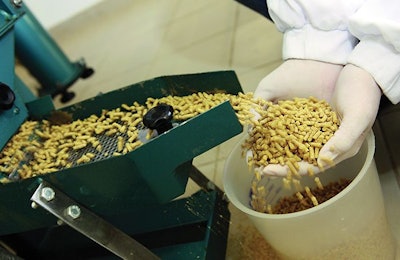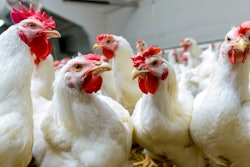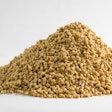
Improving cereal starch digestibility in animal diets is crucial for enhancing nutrient utilization and overall animal performance. This is even more important when cereal prices increase, or competition from the human food chain reduces cereal availability. Here are six strategies to enhance cereal starch digestibility for animals.
1. Processing techniques
Heat treatment: Thermal processing methods such as steam-flaking, extrusion and cooking can disrupt the crystalline structure of starch granules, making them more susceptible to enzymatic digestion. Heat treatment increases the availability of starch for enzymatic breakdown in the digestive system.
Micronization: This involves grinding the grains into very fine particles, increasing the surface area available for enzymatic action. Micronized cereals have improved digestibility compared with their whole-grain counterparts.
2. Enzymatic supplementation
Addition of enzymes: Supplementing animal diets with exogenous enzymes, such as amylases, beta-glucanases and xylanases, may help break down complex starch molecules into simpler sugars. This is particularly beneficial for monogastric animals like poultry and swine that, under certain conditions, may experience limited endogenous enzyme production.
Microbial fermentation in ruminants: In ruminant animals, improving microbial populations in the rumen through probiotics or direct-fed microbials can enhance the fermentation of starch, converting it into more readily digestible products. However, here there is a delicate balance between starch and fiber fermentation that, if not monitored, can lead to metabolic disorders.
3. Genetic selection and modification
Breeding for higher digestibility: Selective breeding programs can focus on developing cereal varieties with improved starch digestibility. Genetic modification techniques can also be employed to enhance the expression of enzymes involved in starch breakdown. The latter remains a matter of political controversy, but the science remains solid.
4. Balancing nutrient composition
Diet formulation: Achieving a balanced diet that includes the right combination of fiber, protein and other nutrients is essential. A well-balanced diet can optimize the conditions for starch digestion and absorption in the digestive tract. This is of paramount importance for ruminants (see above about digestive health) as in monogastrics it is feed efficiency that suffers the most from unbalanced diets.
Fiber inclusion: Including moderate levels of fiber can enhance the overall gut health of animals and support a more stable digestion process. Fiber helps regulate the passage of digesta through the digestive tract, influencing starch digestion kinetics. However, as we have discussed in previous blogs, not all fibers are the same and selecting the right fiber profile remains a challenge.
5. Feed particle size management
Grinding and particle size: Reducing the particle size of cereals through grinding increases the surface area available for enzymatic digestion. Proper particle size management ensures that the feed particles are small enough to be efficiently digested by the animal. However, very fine grinding is not recommended for ruminants and poultry as this goes against their digestive physiology.
Pelleting: Pelleting involves compressing feed particles into pellets. This process can improve starch gelatinization (cooking), making it more accessible for enzymatic digestion. Pelleting can also enhance feed intake and reduce selective feeding.
6. Monitoring and optimization
Digestibility trials: Conducting digestibility trials using different feed formulations and processing methods helps assess the effectiveness of specific strategies. Regular monitoring allows for adjustments to be made to optimize the diet for maximum starch digestibility. Today, there are service providers for exactly this process and, although it is costly, it offers a marketing advantage for specific sensitive feeds (piglets, for example).
Nutrient analysis: Regularly analyzing the nutrient composition of feed ingredients helps ensure that diets meet the nutritional requirements of animals. This allows for adjustments based on the digestibility of specific components, including starch. We recently have experienced wheat with up to 18% crude protein, but with reduced/altered starch composition/profile.
In conclusion, implementing a combination of these strategies, tailored to the specific needs and digestive physiology of the target animal species, can significantly improve cereal starch digestibility in animal diets.

















